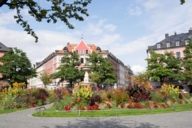
The Gärtnerplatz and Glockenbach neighbourhoods are known as trendy quarters. Their independent labels, hip bars, pubs and cool inns attract the young and the young-at-heart.
These two districts between the Altstadtring road and Isar River are often lumped together. Separated only by Fraunhoferstrasse, Gärtnerplatzviertel stretches to the east while Glockenbachviertel spans to the west. The districts are named after Friedrich von Gärtner, the architect to King Ludwig I in the 1800s, and the Glockenbach stream, which now runs underground.
Gärtnerplatz square itself is dominated by the Staatstheater am Gärtnerplatz theatre, which is one of the city’s top spots for operettas and musicals. The other sides are lined by three and four-storey buildings, carefully colour-coordinated in various shades of red, known to residents as “Gärtnerplatz red”.
With its unique circular layout, lush, colourful flower beds and fountain in the centre, Gärtnerplatz exudes an atmosphere like nowhere else in the city, making it the ideal place to hang out and relax. Cafés and restaurants are scattered amongst small boutiques and grocery stores. The leisurely shoppers that stroll the streets in the day turn into theatre-goers at night.
The square reflects the philosophy of the entire neighbourhood: a colourful community. Singletons and large families, young and old, straight and LGBT – everyone feels equally at home here. In summer, Gärtnerplatz is an especially popular spot for meeting friends, watching the world go by, having a chat or even a flirt.
The square reflects the philosophy of the entire neighbourhood: a colourful community. Singletons and large families, young and old, straight and LGBT – everyone feels equally at home here.
Gärtnerplatz and Glockenbachviertel are famous for their nightlife and alternative culture. Their hip bars, pubs and hangouts draw in the crowds. It's a chic place to chill, and is quite popular among the young and the young at heart.
The traditional all-night kiosk on Reichenbachbrücke bridge is on hand to serve drinks and small snacks, while a few curry joints also do their best business between 2 and 3 in the morning. This district is also still home to a fixture of German life that has all but disappeared: the "Steh-Kneipe", a corner pub where guests are required to stand.
The latest trend is a cross between a restaurant and a dance club. You can spend the whole night at an establishment like this, without having to seek out a new location for all your various entertainments.
Taking a glimpse behind the façades reveals peaceful, idyllic courtyards and gardens, workshops and shops that date back to the 1950s and 60s, dotted between small, pleasant and unique pubs and cafés.
Individuality is a big priority. This is reflected by the huge array of independent labels, where traditional Bavarian dress meets Africa, and the miniature artisan workshops, such as tailors, hardware stores and textile shops. Creative names like “Blutsgeschwister” (Blood Siblings), Café “Herzschmerz” (Heartache Café), the hardware store “Schrauben-Mutter” (Mother of Screws) and “Götterspeise” (Food of the Gods) spark the interest of passers-by.
The neighbourhood is closely tied to the origins of institutions like the convent of the Niederbronner Sisters, which also houses a girls’ home, and a local Munich bakery and pastry shop that still bakes its products in the heart of the city. Another neighbourhood institution is the priest at Maximilianskirche church, Rainer Maria Schiessler. His creative services and events are legendary, like his vehicle blessings, for instance, or mass for animals.
The first gay pubs and initiatives for promoting sexual equality launched here back in the 1960s. Life in Munich’s LGBTQ community also plays out here in the trendy Glockenbach and Gärtnerplatzviertel neighbourhoods with their alternative bars, clubs and stores, the majority of which are based around Müllerstrasse.
Members of the LGBTQ community have found both their home and their freedom here. Proudly declaring yourself to be gay or lesbian has not raised any eyebrows around here for a long time.
The scene’s wildest period came during the 1980s. Queen frontman Freddie Mercury, who chose the Bavarian capital to become his second home, threw legendary parties in the hottest spots of the day, like Old Mrs Henderson (now home to Paradiso Tanzbar), Deutsche Eiche, or Frisco (now Vertigo). He loved Munich so much that he even moved into a flat on Hans-Sachs-Strasse for a short period of time.
Rainer Werner Fassbinder, one of the biggest names in the Neue Deutsche film scene of the 1970s and 80s and founder of Munich’s Antitheater group, also lived on Reichenbachstrasse for four years – with a view over his local pub Deutsche Eiche.
The district’s message to visitors to the city is clear: Munich shines – in all the colours of the rainbow!
Become curious? In our format "Out and about with..." our author walks with the jewelry designer Saskia Diez through the Glockenbachviertel. She not only gives tips, but also tells us what she particularly likes about the area.